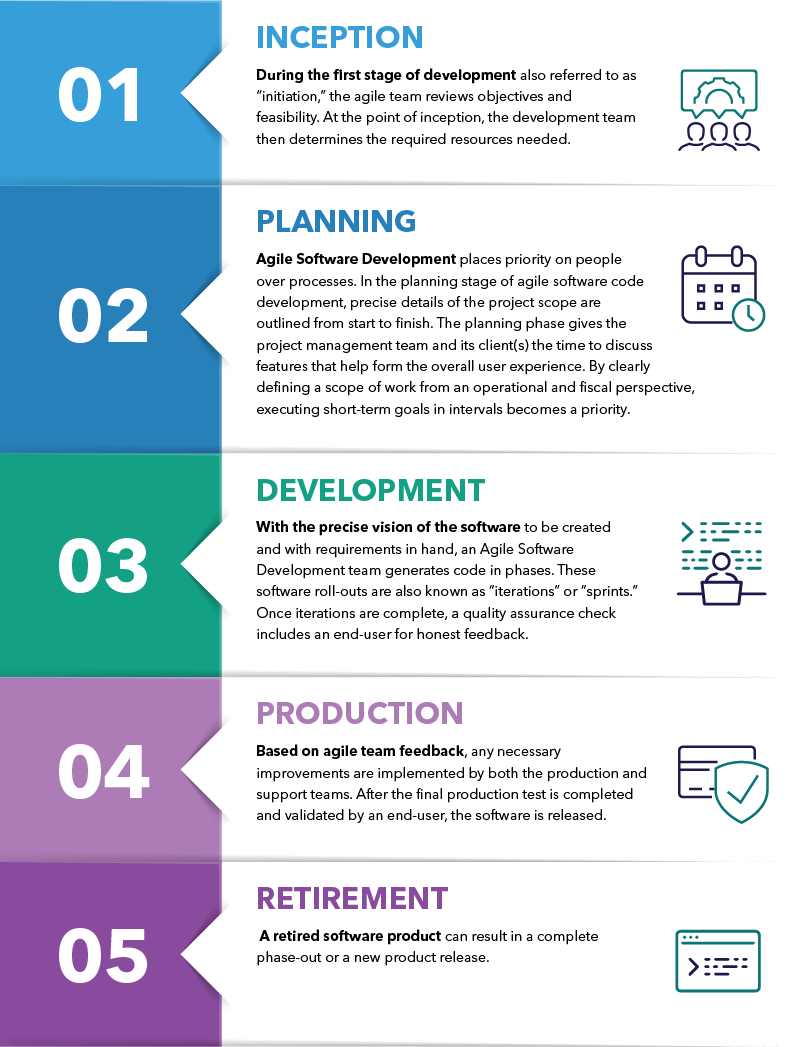Agile development accelerates business continuity for organizations.
In today’s fast-paced business climate, agile companies can quickly meet or exceed expectations. Agility also applies to custom software development. Unlike traditional software development models with testing at the final stage, Agile Software Development speeds the production process by generating code with continual feedback, changes, and tests.
Agile Software Development begins with a vision, essentially a wish list of features that evolve to form an outline. The outline is the basis for the first software code iteration that is then made available to the client for review and feedback. Based on the feedback received, the Agile Software Development team then updates and releases another iteration of the software code. Each revision (iteration) of usable software code is released incrementally, typically in 2-4-week intervals. Agile Software Development gives the client a functional software product in phases – phases that help resolve any discovered risks or challenges through testing.
This transparent and accountable collaborative project management model requires continual engagement by software development and support teams as well as the client. The process includes daily and bi-weekly planning for software iterations to be produced by the collaborative team. Incremental releases of software code allow for product quality testing, validation, and feedback from end users.
Agile Software Development is designed for efficiency, giving clients precisely what they envision, much faster than traditional methods.
AGILE SOFTWARE APPLICATION DEVELOPMENT STAGES
Software created with an agile system produces a high-quality product. Agile Software Development stages include:
- Inception – During the first stage of development also referred to as “initiation,” the agile team reviews objectives and feasibility. At the point of inception, the development team then determines the required resources needed.
- Planning – Agile Software Development places priority on people over processes. In the planning stage of agile software code development, precise details of the project scope are outlined from start to finish. The planning phase gives the project management team and its client(s) the time to discuss features that help form the overall user experience. By clearly defining a scope of work from an operational and fiscal perspective, executing short-term goals in intervals becomes a priority.
- Development – With the precise vision of the software to be created and with requirements in hand, an Agile Software Development team generates code in phases. These software roll-outs are also known as “iterations” or “sprints.” Once iterations are complete, a quality assurance check includes an end-user for honest feedback.
- Production – Based on agile team feedback, any necessary improvements are implemented by both the production and support teams. After the final production test is completed and validated by an end-user, the software is released.
- Retirement – A retired software product can result in a complete phase-out or a new product release.
Prakat Test Engineering Services: A Scalable Framework. Testing Excellence.
Prakat’s Agile Software Development test center environment deploys roadmaps that include scalable frameworks and continuous testing. The result? Modular, reusable, and cost-effective software code development that delivers new software products with speed, skill, and accuracy. Prakat’s meticulous team approach focuses on increased efficiencies and improved return-on-investment opportunities.







